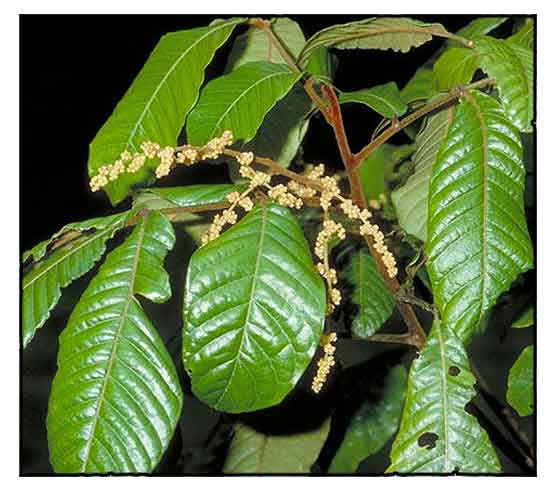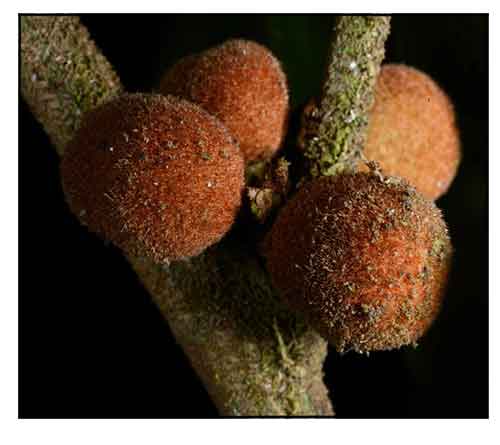
Family • Meliaceae
Karamiras
Aglaia tomentosa Teijsm. & Binn.
BAYANTI
| Scientific names | Common names |
| Aglaia tomentos Teijsm. & Binn. | Arangnang (Dumagat) |
| Accepted infraspecifics | Bayanti (Tagalog) |
| Aglaia tomentosa subsp. cordata (Hiern) Pannell | Karamiras (Tag.) |
| Aglaia cordata Hiern | Maybosug (Yakan) |
| Aglaia tomentosa subsp. kabaensis (Baker f.) Pannell | Mata-mata (Sulu) |
| Aglaia kabaensis Baker f. | |
| Aglaia tomentosa subsp. tomentosa | |
| Aglaia bamleri Harms | |
| Aglaia dyeri Koord. | |
| Aglaia elaphina Merr. | |
| Aglaia glomerata Merr. | |
| Aglaia harmandiana Pierre | |
| Aglaia minutiflora Bedd. | |
| Aglaia minutiflora var. travancorica Hiern | |
| Aglaia minutiflora var. longifolia Craib | |
| Aglaia polyantha Bedd. | |
| Aglaia ramuensis Harms | |
| Aglaia rufa Miq. | |
| Aglaia zippelii Miq. | |
| Euphora exstipularis C.DC. | |
| Euphora exstipularis Griff. | |
| Milnea harmandiana Pierre | |
| Aglaia tomentosa is an accepted species. KEW: Plants of the World Online. | |
| In the confusing landscape of common names in the Philippines, Bayanti is shared by three Aglaia species: A. edulis, A. rimosa, and A. tomentosa. | |
| Other vernacular names |
| BORNEO: Bunau, Kumpang penjaru, Lantupak, Sampak tupai, Segera, Umpong. |
| INDONESIA: Awa saelu saelu datan, Kayu si rah-rah batu, Malasot. |
| MALAYALAM: Neermulli, Nirmula, Nirmulei. |
| MALAYSIA: Buan patung, Medang belulu, Redan, Lambunau burong. |
| THAILAND: Sangkhriat-langsat. |
Botany
Distribution Constituents Properties Studies Availability |
Updated September 2025
August 2023
![]()
 |
| PHOTOS / ILLUSTRATIONS |
| IMAGE SOURCE: Aglaia tomentosa / Flowering branch / Copyright © B. Gray / Australian National Botanic Gardens / click on image or link to go to source page / Non-Commercial Use / image modified / Useful Tropical Plants |
| OTHER IMAGE SOURCE: Aglaia tomentosa / Lee Chin Chai / Non-commercial use / image modified / Click on image or link to go to source page / HKCWW.Malaysia Plant Database |
| OTHER IMAGE SOURCE: Aglaia tomentosa -- closeup of immature fruits / Ehoarn Bidault / CC BY NC-ND / image modified / Clilck on image or link to go to source page / Useful Tropical Plants |
Additional
Sources and Suggested Readings |
• |
DOI: It is not uncommon for links on studies/sources to change. Copying and pasting the information on the search window or using the DOI (if available) will often redirect to the new link page. (Citing and Using a (DOI) Digital Object Identifier) |
| List of Understudied Philippine Medicinal Plants |
| New plant names needed The compilation now numbers over 1,730 medicinal plants. While I believe there are hundreds more that can be added to the collection, they are becoming more difficult to find. If you have a plant to suggest for inclusion, native or introduced, please email the info: scientific name (most helpful), local plant name (if known), any known folkloric medicinal use, and, if possible, a photo. Your help will be greatly appreciated. |
• |
 |




